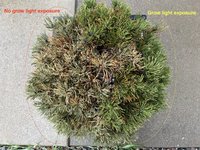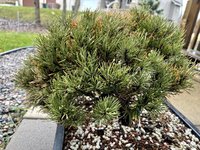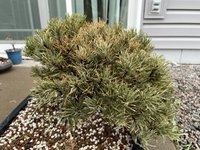I believe that where winter temps are consistently in the mid 30’s F or colder, the pines, regardless of species, are metabolically so slow as to not require any light... think alpine evergreens under 10 feet of snow. I’ve personally kept jbp, jrp, and shimpaku in a garage with one north facing window for upwards of 4 months every winter, frozen on the concrete floor. For over a decade, they went in at thanksgiving and went out around April first and never skipped a beat. This was in MA over a decade when we still had consistently cold winters and I could keep them frozen. I’d say all bets are off if the temps hover at or over 40 F for more then a few days, though. Down here in tropical 7b N GA, those same trees stay on my benches all winter except for during the coldest week or two, soaking up whatever sun hits my backyard this time of year.
I think I'm at that point in my bonsai journey where I can slowly begin giving my two cents of knowledge, rather than simply take in knowledge from all the experienced folk. With that being said, I'd like to give insights on an experiment I did that seem to somewhat confirm what
@Dav4 is saying.
In this experiment, I had a mugo pine that had two trunks. The tree was stored in a cold shelter (unheated garage) with a grow light (brand: Spider). Over the course of the winter, the temperature fluctuated between 20F to 40F in the garage, more often than not above freezing (32F). I tried to somewhat control this temperature using a similar system that
@JudyB uses. Importantly, one trunk received more light than the other. You will see the result of this experiment below.
Clearly, one side of this mugo pine is thriving, whereas the other not so much. The trunk that received less sunlight, right now, will have foliage that easily pulls off. I will monitor how the buds do over the next few weeks, but I would not be surprised about dieback. This doesn't mean that storing a mugo pine without sunlight will kill it. However, it does mean that a mugo pine may begin "prioritizing" which foliage/branches to keep if only one portion receives sunlight. In other words, this mugo pine didn't go fully dormant because of my temperature control. My takeaway: if our local climate or cold shelter is above freezing so that the tree is metabolically active, then the tree likely needs sunlight. If there is uneven amount of sunlight on certain parts of the tree (at least in mugo pines), the tree may begin prioritizing which foliage/branches to keep. This is in line with what I have observed with shaded parts of trees. How come trees buried under snow don't lose branches? My garden Scot's pines look fine, for example. The key difference is that photosynthesis and transpiration is occurring when you store these trees in a cold shelter. There is a difference between trees grown in a pot vs in the ground. I assume that you would not observe this if you kept trees buried under snow, below freezing over the winter. I probably could have, since it's a mugo pine. However, for sake of adding knowledge to the community, I took a hit on this tree

I would also like to note that talking to people in YOUR local climate is paramount. There were people in the MN Bonsai Club that have consistently noticed that winter sunlight leads to better ramification in ponderosa pines. But can they live without sunlight? According to MN people, yes. However, if you're someone like Ryan Neil out in the PNW, as he says, pines do much better if they have sunlight in the winter. Why? Because there is transpiration and photosynthesis going on at those winter temperatures. In MN, transpiration is more or less halted. BUT. In the garage or cold shelter, maybe not so...
Hope this contributed to the discussion!




